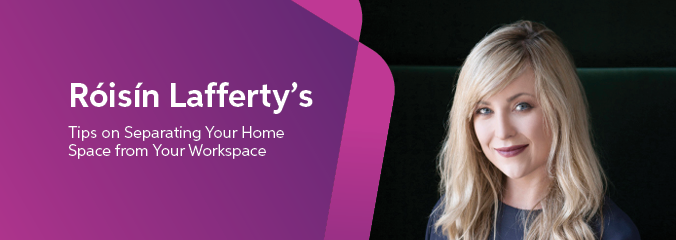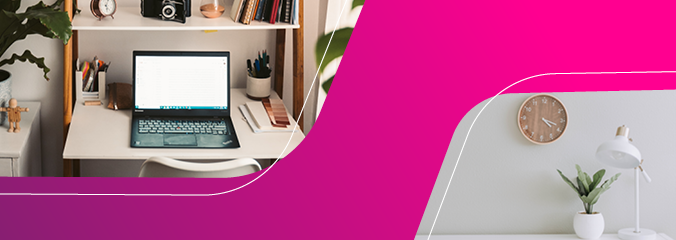
In the past when looking at buying a property, having a home office or study was a ‘nice to have’. Today it’s become a necessity for so many people, regardless of what kind of home you want to buy. At AIB, we know that people want a smart solution that enables them to either get multiple uses out of a space for living, entertaining and working. With remote learning and working here to stay, it’s important to factor this in when you’re buying a property in a way that makes you enjoy the space instead of having it as a mere afterthought in the design process. We spoke to award-winning Interior Designer Roisin Lafferty shares her top tips for creating a home office, designing a Zoom background that keeps you professional and the best way to embrace the light in your home.
How to Create a Home Office
When I’m busy I find the space around me can become super messy, the piles grow and grow wherever I land my head. Being able to tidy things away is important.
One solution is to build in a desk space if you’re having any joinery done. A built-in storage wall in a living room or playroom is perfect for this. You don't necessarily need a lot of space for a home office, just a simple desk with doors that fold in. That then means that psychologically, you can shut it all away.
For a lot of people though, the realistic requirement is dual functionality. The most important thing to remember is to try and separate the functions. So, if you’re working at the dining table, it’s vital to then clear work away when you’re having a meal so that you’re clearly separating work life and home life.
The key is to try to create the feeling of different environments, even when you can’t necessarily have different rooms.

Stylish Zoom Backgrounds
I like to leave my desk and take my Zoom calls in a different room. That way it almost feels like I’m going to a meeting.
Remember that even though you’re working from home it’s still important to create a professional environment, so think about where your colleagues or clients will see when you’re on camera. Don’t overthink things, it doesn’t need to be complex. A plain wall with a piece of art on it or against it will look appealing on camera and you would never know if the rest of the house is falling apart!
Natural light is vital here. Artificial and overheard lights are very harsh and unflattering so try to face a window with lots of light coming in.
Room Colour and Light
For me, colour is all about the feeling and the energy that something gives off. These days your house is your bubble, you’re both living and working at home and it’s so important to make yourself feel happy there. In the same way you dress yourself in a personal style, you should express yourself in your home too.
People often don't know how to go about introducing colour or where to start. Reference pictures are great, so go to Instagram and Pinterest and look up similar types of properties. Find images that you’re instantly drawn to and then trust your instincts on it. Keep holding onto the image that you really loved if you’re tempted to dilute it down. Remember that it’s not until it’s completed on a larger scale that you’ll get the real impact.
The importance of natural light can never be underestimated. It is the most priceless thing. Do your upmost to maximise the light in your home. Don’t let curtains eat into the window – run your curtain track the full width of the wall and open the curtain fully to either side of the window. That automatically tricks your mind and makes it feel like there's much more natural light.
Darker rooms don’t necessarily need to be painted to be brighter, embrace that cosy feeling. Try to spend your time or have your home office in rooms that have lots of natural light during the day and then embrace the cosiness of darker rooms later.

An Eclectic Mix
Personally, I like the story of things that have been passed down and love an eclectic blend of furniture from different places, but to integrate a mix of pieces well you need to be mindful of a few things. Only take things you genuinely like. Furniture can be big and bulky and if you don't like it, and you're not sure it's going to work, don't take it.
A lot of older furniture can be quite bulky so doesn’t always work in newer houses. Consider shapes and proportions and how the pieces might fit into your home. Don’t be afraid to have fun with older pieces, if you're given a big old desk, you could change the leather on it or add a cool mid-century chair, and almost make it the sculpture in the room.
I love places like Zara Home for little things that make a big difference like handles, throws and cushions. Swapping the knobs and handles on units and kitchens can make a huge change and adding textiles to couches and chairs is a great way to add colour without a big commitment.
Whatever your personal taste, the one thing we all have in common is wanting to turn a house into a home. Design can sometimes be daunting, especially if it’s your first property. Remember that not everything has to be done at once – a comfortable couch, a place to work, a bedroom that’s cosy and a kitchen you can cook in is a great start, the rest will follow.
Ready to Start your Mortgage Journey?
Whether you are buying your first home, moving home or just have a mortgage question, our expert team of mortgage advisers are here to help. Click here to find out more.
Follow us on Instagram @AIB_Northernlreland to keep up to date on news, events and features.
